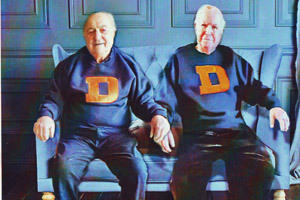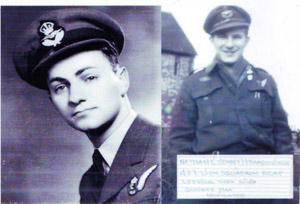Features
A replica jersey from a 1930s Jewish boys club in Winnipeg evokes fond memories for one of the members of that club

By BERNIE BELLAN In September 2020 I wrote a story about a long-ago Jewish club that went by the name “The Rollickers”. That story was prompted by my reading the minute book of the club, which had been in the hands of Rona Perlov, whose father, Eli Weinberg, was a founding member of the club. (By the way you can read that story on this website. Simply enter the name “The Rollickers” in our search engine.)
While reading that minute book certainly evinced a few laughs – those young guys spent more time debating about who should be punished for violating arcane rules about what constituted unacceptable behavior than anything else, I noted in my story that there was never any reference in the minutes to sports.
I wondered about that. While the YMHA on Albert Street didn’t open until 1936, there have been many stories written about great Jewish athletes from Winnipeg in the early part of the 20th century. Were they organized, I wondered? Did they have clubs?
My questions were partly answered a few weeks ago when I received a call from someone by the name of Murray Atnikov. It turned out that Atnikov was a former Winnipegger, now living in Vancouver, who had a story he wanted to share with me, but which he wanted to tell me in person. He would be coming to Winnipeg in August, he told me, and asked whether we could meet when he got here.
“Sure,” I told him. I was intrigued to find out what his story was.
Subsequently, Atnikov (who I learned, after talking to him on the phone when he called me again) is better known as Dr. Murray Atnikov, an anaesthesiologist who had left Winnipeg many years ago, came over to my house one beautiful summer day, complete with a folder which he didn’t open until we were well into our conversation.
When he was a teen in the 1930s, Atnikov told me, he belonged to a north end Jewish sports club known as “The Demons”. There was only one other surviving member of that club: Nathan Isaacs (née Isaacovitch), now a resident of Toronto (and a longtime subscriber to this paper, I might add.)
There was at least one other Jewish sports club of that era, Atnikov recalled, known as “The Eagles”. Members of both clubs played hockey, softball, and football, and their competition came from non-Jewish clubs in the area. When I asked Atnikov whether any of the boys curled, he said that was something older men did, but interestingly he told me that there was actually a football field located behind what was the Maple Leaf Curling Club on Machray, which was where the Demons and the Eagles played their games.

But why did Atnikov want to see me in person, I wondered? It turns out that in his folder he had some photographs, including one of him and Nathan Isaacs when they both served in the Royal Canadian Air Force, but also one of the two of them wearing replica sweaters emblazoned with the letter “D” for Demons.
As Atnikov explained to me, a son of one of their late colleagues had been going through his father’s belongings after his father had passed away when he came across an original “Demons” sweater from the 1930s.
Knowing that Atnikov and Isaacs were the two surviving members of the Demons, this fellow had the replica sweaters made up and shipped to Atnikov and Isaacs. Recently the two old friends had a chance to visit with one another – thus the photo you at the beginning of this story.
So, where did Murray Atnikov end up after the war, I wondered? As he sat with me on my front step, regaling me with one fascinating story after another, he explained how he ended up in Vancouver.
In 1945 Atnikov was one of a group of three friends who had applied to enter medical school here in Winnipeg. Although the quota on Jewish students had just been lifted, thanks to a legal battle entered into by such individuals as Percy Barsky and Hyman Sokolov (which has been well documented both in this paper and numerous other sources), it was still no easy matter for Jewish students to get into medicine here.
As a result, Atnikov said, he and his two friends boarded a train for Chicago, where they intended to apply to the University of Chicago’s medical school. While all three were accepted, Atnikov explained, they were told that there were two different streams within the medical school. In one stream, once you graduated, you would be allowed to practice medicine anywhere in the U.S. Within the other stream, however, you would be allowed to practice medicine only in Illinois. (For how long you’d have to remain in Illinois I’m not sure. I also didn’t ask Atnikov whether he knew the answer.)
Not wanting to be forced to remain in Illinois, however, Atnikov said he decided to return to Winnipeg and see whether there was any chance he might still be able to get into medical school here. Upon returning home and contacting the medical school yet again though, he was disappointed to learn that his name was still not on the list of entrants to the new year of school.
Although disappointed, you can imagine Atnikov’s elation when he received a follow-up call from the same person who told him his name was not on the list of medical school entrants to say that a mistake had been made. Apparently when the three young men had gone to Chicago and had all been accepted into medical school there, one of the other two guys phoned the medical school here to say that they could remove their names from the list of applicants to school in Winnipeg because they had all been accepted in Chicago.
It turns out that, while Atnikov was not immediately accepted into medical school, he was number two on the wait list and, pending two other students dropping out of school, he would get in – which he did.
Upon graduating from medicine in 1950, however, Atnikov left Winnipeg to advance his medical education at the University of Minnesota. One of his colleagues there was Norman Shumway, he told me, who later became an early pioneer of heart transplant surgery. (According to Atnikov, Christian Barnaard, who performed the first-ever heart transplant on a human, learned his technique from Shumway when they were both colleagues at the University of Minnesota in the 1950s.)
Atnikov went on to have an illustrious career as an anesthesiologist, in New York, California, and ultimately, Vancouver, which is where he eventually retired from practicing.
Still, after all these years, with all that he has accomplished, Murray Atnikov was most interested in talking about the Demons and what great times they had together.
Those boyhood memories – and girlhood ones too: They never cease to fade and reliving some of those experiences is what keeps so many of us going.
Features
Guest Article — A Canadian Jewish Traveller’s Money Playbook: Smarter FX & Safer Digital Finance for Israel Trips and Beyond
Written for readers of jewishpostandnews.ca
Whether you’re flying to Israel for a simcha, helping a student with a gap year, supporting family abroad, or making a donation to a cause you care about, the way you move money matters. Small choices around foreign exchange (FX), card settings, and digital security can quietly cost—or save—you hundreds of dollars per trip. This guest guide keeps things practical and non-hyped, with steps you can use right away.
1) Foreign Exchange: Focus on the all-in cost, not just the posted rate
Most leaks happen in three places: spreads (the markup over interbank), fees(ATM/operator/bank), and terminal settings (dynamic currency conversion, or DCC).
Winnipeg-to-Israel routine (works for most routes):
1. Always pay in the local currency. In Israel, choose ILS at the terminal; in the U.S. leg of a connection, choose USD. Decline DCC—letting the terminal convert to CAD usually costs more.
2. Separate rails by purpose.
○ Everyday spending: use a low/no-FX-fee card.
○ Larger cash or transfers: get a quote from a specialist and compare with your bank’s total cost (rate plus fees).
3. Stage big conversions. If the rate feels jumpy, split a large exchange into two or three tranches to average your price.
4. Carry a small cash float. Enough for taxis, tips, markets, and rural stops—then default to card for everything else.
5. Log your effective rate. Screenshot ATM and card receipts so you can see the actualCAD cost later.
Starting point to benchmark retail quotes: check posted rates, ID requirements, and pickup logistics via currency exchange in Ontario (useful if you or your student connect through Toronto/YYZ or spend time in the GTA before departure).
2) Israel-specific tips (simchas, tours, and longer stays)
● Hotels & car rentals: expect hefty holds on credit cards; keep extra available limit to avoid declines.
● Transit & payments: most urban vendors take cards, but small kiosks and markets may prefer cash; keep some small ILS notes.
● Receipts for donations & tours: store PDFs in one folder (cloud + offline) with a simple naming format (YYYY-MM-DD_vendor_amount). It saves time at tax season and for warranty/claim issues.
3) Tuition, program fees, and family support
Moving four- or five-figure sums? The spread matters more than you think.
● Shop the spread: get at least two quotes on the same day (bank vs. specialist).
● Confirm the lock: ask how long the rate-hold window lasts and the funds-received cut-off to avoid re-quotes.
● Proof of payment: save wire confirmations and the beneficiary’s receipt; mismatched names or references can delay admission or housing.
4) Tzedakah and cross-border donations (general guidance)
● Ask for the right receipt: Canadian tax receipts require a registered Canadian charity number; many Israel-based organizations partner with Canadian affiliates—ask before you give.
● Card vs. wire: cards are fast but may carry higher total cost on large gifts; wires are slower but can be cheaper for size.
● Record-keeping: store the acknowledgement email, PDF receipt, and card/wire confirmation together.
(This section is informational—always seek professional tax advice for your situation.)
5) If you hold a little crypto (optional)
Crypto isn’t for everyone, but if you already hold some—or your student does—treat it like an operations problem: keys, backups, and off-ramps.
Minimum viable safety
● Self-custody for long-term funds: use a hardware wallet; keep a small hot-wallet only for spending.
● Never store seed phrases in email or cloud notes. Write them down and secure them (consider splitting and sealing).
● On/off-ramp drill: before you travel, do a tiny test withdrawal to confirm access and speed; save TX IDs and exchange statements.
If you’re scaling exposure or want a security-first setup (custody architecture, recovery run-through, incident response), consider a session with crypto investment consultants.
6) One-page checklists you can save
Travel Day (Israel or U.S. connection)
● Card set to pay in local currency (decline DCC)
● Small test purchase completed on arrival
● Shortlist of ATMs with known operator fees
● Cash envelope for day-one expenses
● Offline copies of bookings + insurance on your phone
Large FX Transfer (tuition/deposit/donation)
● Two quotes captured (bank vs. specialist)
● Rate-lock window and cut-off confirmed
● Screenshots with timestamps saved
● Wire confirmation + beneficiary receipt filed
Crypto Hygiene (if applicable)
● Hardware wallet initialized; seed written and stored safely
● 2FA keys offline; password manager updated
● Test withdrawal completed; TX IDs logged
● Quarterly: verify balances, rotate credentials, re-test recovery
jewishpostandnews.ca serves readers with local, diaspora, and Israel coverage—readers who routinely plan Israel trips, support causes, and help students abroad. Practical money ops reduce friction on exactly those journeys.
Bottom line (and a small disclaimer)
You don’t need to “time the market.” Use the cheapest reliable rail for each job, avoid DCC, stage large conversions, and keep clean records. If crypto is in your mix, run it with production-grade safety. This article is informational only, not financial, tax, or investment advice; consult qualified professionals for your circumstances.
Features
Why some Satmar Hasidic leaders endorsed Zohran Mamdani as mayor, stunning many Jewish voters

By Jacob Kornbluh November 2, 2025
This story was originally published in the Forward. Click here to get the Forward’s free email newsletters delivered to your inbox.
A surprise endorsement of Zohran Mamdani by a faction of the Satmar Hasidic community has set off a firestorm within the community, exposing sharp internal divisions about the Democratic nominee struggling to earn the trust of many Jews in the race for New York City mayor.
On Sunday, Rabbi Moshe Indig, a political leader of the sect led by Rabbi Aaron Teitelbaum from Kiryas Joel and known as the Ahronim, publicly declared his support for Mamdani at a meeting he organized in Williamsburg.
But within hours, three prominent leaders of the Ahronim sect issued a joint statement rejecting the move and announcing their own endorsement of former Gov. Andrew Cuomo, who was the community’s preferred candidate during the Democratic primary.
Indig, a leading political figure in the Ahronim camp who had praised Mamdani earlier in the campaign as “very nice, very humble” and “not antisemitic,” has not commented publicly since the backlash unfolded.
Why it matters
For Mamdani, who has sought to defuse criticism of his anti-Israel statements through quiet outreach to Haredi leaders, the turmoil reflects both his progress and the limits of his effort.
The approximately 80,000 voters in Brooklyn’s Haredi communities, where rabbinic dictates about ballot choices lead to a reliable bloc of support, are particularly sought after by candidates. The Satmar community is known for its staunchly anti-Zionist religious ideology.
If Mamdani, a democratic socialist and strident critic of Israel who leads by double digits according to recent polls, wins Tuesday’s election, it would mark the third consecutive mayoral race in which Ahronim’s political arm has demonstrated its political influence by backing the eventual winner, while other Hasidic blocs supported rival candidates.
In 2021, they endorsed Eric Adams over Andrew Yang, who was favored by most leading Hasidic sects. And in 2013, they backed Bill de Blasio, who narrowly avoided a runoff in the Democratic primary by just 5,000 votes, while the Zalonim and other groups supported Bill Thompson, then seen as the frontrunner.
The move to endorse Mamdani came days after Satmar, including the larger sect led by Rabbi Zalmen Teitelbaum from Williamsburg and known as the Zalonim, declared that they would not endorse any candidate for mayor while also condemning the “fear campaign” and attacks on Mamdani. They also met with Cuomo on Wednesday night, accompanied by Mayor Eric Adams, but ultimately declined to back him.
In an open letter to their followers published on Wednesday, the Satmar leadership highlighted Mamdani’s gestures that specifically addressed their concerns. They noted that the Democratic nominee has said he would work to protect Hasidic yeshivas that face scrutiny for failing to meet state education standards and promised that Hasidic families would benefit from his proposals to expand affordable housing and establish universal childcare.
If Mamdani wins, he would become the first Muslim mayor of New York City, home to the largest concentration of Jews in the U.S.
Cuomo still enjoys broad support among Jewish voters, who make up an estimated 10% of the general election electorate. A recent Quinnipiac poll of 170 Jewish voters showed Cuomo with 60% of their support and Mamdani with 16%, while a separate Marist poll of 792 likely voters — including an 11% sample of Jewish voters — found Cuomo with 55% and Mamdani at 32% among Jewish respondents.
Cuomo also has the backing of most Orthodox groups that helped swing the 2021 mayoral race for Adams, including the Flatbush Jewish Community Coalition and the two largest voting blocs in Borough Park — Bobov and Belz. The remaining 25 Hasidic sects and yeshivas in Borough Park have declined to issue a recommendation in the current race.
This story has been updated to include news of a rift in the community after the Mamdani endorsement.
Jacob Kornbluh is the Forward’s senior political reporter. Follow him on Twitter @jacobkornbluh or email kornbluh@forward.com.
This story was originally published on the Forward.
Features
The Technology Behind Real-Time Streaming in Live Dealer Casinos

Live dealer casino games from top-tier providers, such as Evolution Gaming and Pragmatic Play, are experiencing unprecedented popularity. If you’re curious about how these games function and which technologies make these games possible, you’ve come to the right place.
On this page, we will be revealing several key insights into some of the most highly sophisticated real-money betting games available in the iGaming industry.
Anyone who is interested in exploring these cutting-edge games can find a regularly updated list of the most reputable Canadian online casinos that feature top-notch live dealer games on various trusted iGaming review sites.
What are Live Dealer Games at Online Casinos?
Live dealer games at online casinos are broadcast in real-time to your preferred Wi-Fi/internet-connected PC or mobile device, and they feature actual croupiers (human being dealers) to present the action to you.
While some live dealer gameplay originates from traditional land-based casinos, the majority are streamed from specialized online studios designed to replicate the atmosphere of a real casino.
In contrast to computer-generated games such as slots, table games, scratch cards, bingo, lottery-style games, crash games, and video poker, which rely on Random Number Generators (RNGs) to determine outcomes, live dealer games do not utilize RNGs.
However, with that said, live dealer TV game shows with second-screen bonus rounds and live dealer online slot machines DO use frequently tested RNGs to produce the fair and realistic outcomes/results.
This means that live dealer games offer an experience that closely resembles playing in a physical casino.
Which key technologies underpin live dealer casino games?
Live dealer games utilize various advanced technologies to ensure smooth operations across web browsers and modern devices, including smartphones, tablets, laptops, and desktop computers.
The essential technologies employed by online casino software providers and iGaming operators in developing and maintaining live dealer games enable players to enjoy an immersive, engaging, and realistic experience.
The key technologies include:
- Live streaming capabilities
- High-definition (HD) audio and visual features
- Multiple HD cameras
- Optical character recognition (OCR) technology
- Game control units (GCU)
- Instant messaging (IM) text chat features
Let’s now quickly explore what some of these technologies entail.
Multiple HD-ready cameras capture video of live dealer hosts as they deal and present the action in a casino-themed environment. This footage is streamed live over the internet from various angles.
OCR technology scans physical objects, such as cards and chips, transmitting this information to the graphical overlay visible during gameplay, which essentially converts game data into a digital format.
The live streaming capabilities, along with immersive chat features, enable players to view the action, join in live rounds, and communicate with both dealers and fellow players, which significantly enhances the social experience of online gambling.
Final thoughts
To sum up, live dealer technology has elevated online casinos to new heights. To play these games, players must be at least 18 or 19 years old (depending on where you live). For example, in Ontario, you must be at least 18 years old to play, but in other provinces, such as British Columbia, the minimum age requirement stands slightly lower at 18.
In the United States, you must be 21 years old to play live dealer and computer-generated online casino games in the real money mode. If you choose to engage, remember to gamble responsibly and play only on reputable sites operated by trusted entities.
Some of today’s hottest games to check out from leading software providers in 2025 include Live Crazy Balls, Fortune Roulette Live, Live Crazy Pachinko, Live XL Roulette, and Busted or Bailed Live. Additionally, popular titles like Monopoly Live and Live Sweet Bonanza Candyland are also a couple of epic hit titles that are worth exploring.
On a final note, it’s highly recommended to establish either a daily, weekly, or monthly deposit limit to help you stay within your spending budget. You can also set win/loss limits, spending caps, or session time reminders to help keep things safe and fun.


